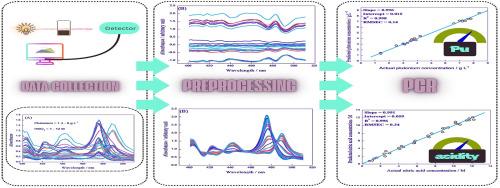多元校准法直接分光光度法同时测定PUREX样品中钚(IV)和硝酸浓度
IF 6
2区 化学
Q1 CHEMISTRY, ANALYTICAL
引用次数: 0
摘要
PUREX工艺旨在定量回收U和Pu,裂变产物去污因子在106范围内。为此,需要在不同的工艺步骤中分析工艺参数。因此,在进行任何工艺之前,必须知道进料溶液中Pu和硝酸的浓度。测定钚和硝酸的传统分析技术会产生大量的二次放射性废物,而且耗时长,增加了人员的辐射暴露风险,特别是在处理短冷或高燃燃料的设施中。因此,有必要开发一种新的方法来确定这两个参数,应该没有上述缺点。结果建立了同时测定PUREX工艺样品中硝酸钚溶液中Pu(IV)和硝酸浓度的分析方法。硝酸钚的吸收光谱随硝酸浓度变化剧烈。因此,在没有事先了解酸度的情况下,直接紫外可见光谱法对钚进行定量是不合适的。因此,在本方法中,紫外可见光谱与化学计量学相结合的方法被用于利用这些酸诱导的变化来估计样品中的硝酸浓度和钚浓度。利用ops辅助PCR方法对浓度为1.4 ~ 8.4 g L-1和硝酸浓度为1 ~ 12 m的钚进行了定量分析,ops有助于使化学计量模型更加稳健和可解释。用实验数据对模型进行了验证,预测钚和硝酸浓度的RMSEP值分别为0.24 g -1和0.21 M。意义所建立的方法简单、快速、可靠。此外,本方法没有任何分析浪费,因为分析后的样品可以与工艺流混合。本方法为直接分光光度法,适于在线监测。本文章由计算机程序翻译,如有差异,请以英文原文为准。


Direct spectrophotometric method for simultaneous estimation of Plutonium(IV) and nitric acid concentration in PUREX samples via multivariate calibration approach
Background
The PUREX process aims at quantitative recovery of U and Pu with fission product decontamination factor in the range of 106. For this purpose, process parameters need to be analysed at different process steps. Therefore concentration of Pu and nitric acid in the feed solution must be known before carrying out any process. Conventional analytical techniques for plutonium and nitric acid determination generate significant quantities of secondary radioactive waste and are time-intensive, increasing the radiation exposure risk for personnel especially in facilities handling short-cooled or high burn-up fuels.Hence, there was a need to develop a new method for determination of both the parameter that should be devoid of above disadvantage.
Results
An analytical method has been developed for simultaneous determination of Pu(IV) and nitric acid concentration in plutonium nitrate solution for PUREX process samples. Plutonium nitrate absorption spectra changes drastically with the nitric acid concentration. Therefore, without prior knowledge of acidity, quantification of plutonium with direct UV-VIS spectrum is not suitable. Therefore, in present method UV-VIS spectroscopy coupled with chemometric approach being used for utilising these acid induced variations for estimation of nitric acid concentration in a sample along with plutonium concentration. OPLS assisted PCR approach has been used for quantifying the plutonium in the concentration range 1.4–8.4 g/L and nitric acid concentration 1–12 M. OPLS help in making the chemometric model more robust and interpretable. The model has been validated with a test dataset with RMSEV values for prediction of plutonium and nitric acid concentration are 0.24 g/L and 0.21 M respectively.
Significance
The developed method is simple, fast and reliable. Also, present method is devoid of any analytical waste as sample after analysis can be mixed with the process stream. This method is direct spectrophotometric method and hence amenable for online monitoring.
求助全文
通过发布文献求助,成功后即可免费获取论文全文。
去求助
来源期刊

Analytica Chimica Acta
化学-分析化学
CiteScore
10.40
自引率
6.50%
发文量
1081
审稿时长
38 days
期刊介绍:
Analytica Chimica Acta has an open access mirror journal Analytica Chimica Acta: X, sharing the same aims and scope, editorial team, submission system and rigorous peer review.
Analytica Chimica Acta provides a forum for the rapid publication of original research, and critical, comprehensive reviews dealing with all aspects of fundamental and applied modern analytical chemistry. The journal welcomes the submission of research papers which report studies concerning the development of new and significant analytical methodologies. In determining the suitability of submitted articles for publication, particular scrutiny will be placed on the degree of novelty and impact of the research and the extent to which it adds to the existing body of knowledge in analytical chemistry.
 求助内容:
求助内容: 应助结果提醒方式:
应助结果提醒方式:


